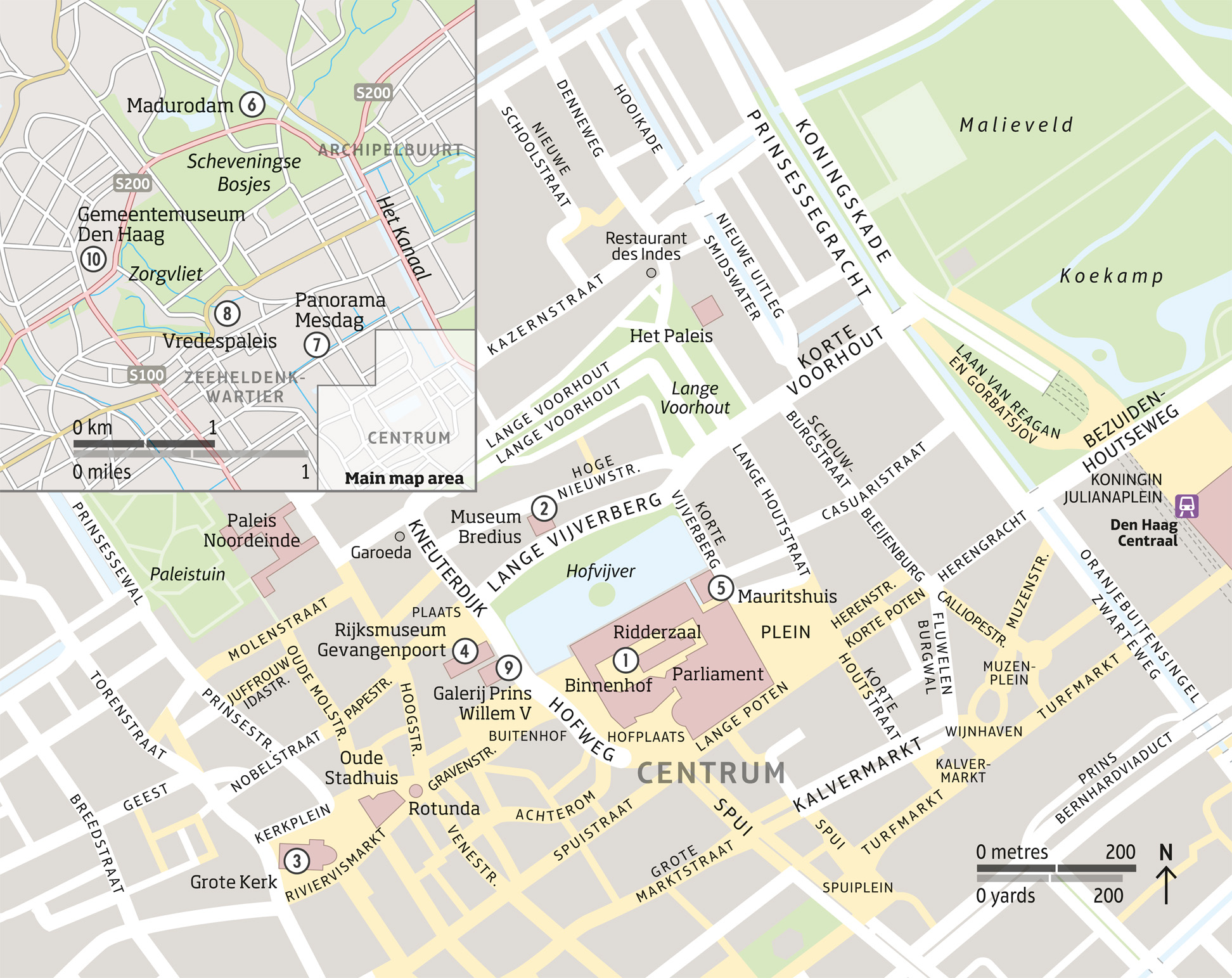
S4 ⌂ 56 km (35 miles) SW of Amsterdam £ Centraal Station, Koningin Julianaplein; Station Hollands Spoor (HS), Stationsplein n Spui 68; noon–8pm Mon, 10am–8pm Tue–Fri, 10am–5pm Sat & Sun; www.denhaag.com
Den Haag (’s-Gravenhage or The Hague) became the political capital of the Netherlands in 1586 and is home to prestigious institutions such as the Dutch Parliament and International Court of Justice.
Beyond The Centre Must See

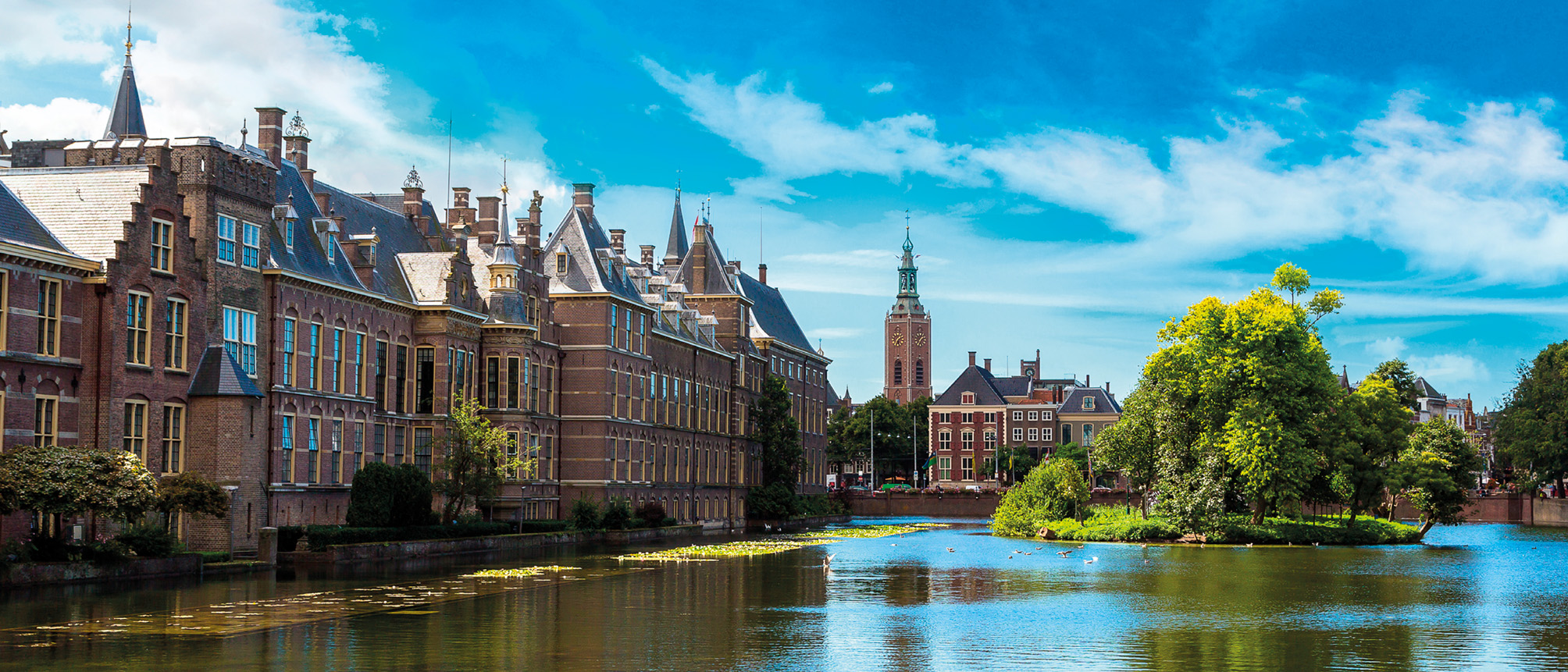
t The grand Binnenhof, sitting on the tranquil waters of the Hofvijver lake
The former castle of the counts of Holland is now home to the Dutch Parliament and the office of the Prime Minister of the Netherlands. Known as the Binnenhof, this complex of buildings sits beside the castle’s former moat – the Hofvijver. In the centre of the courtyard stands the fairy-tale, double-turreted Gothic Ridderzaal (Hall of the Knights). This was the 13th-century dining hall of Floris V, Count of Holland (1254–96). Since 1904, the hall’s function has been mostly ceremonial; it is used for the opening of the Dutch Parliament by the monarch (Prinsjesdag, the third Tuesday in September), and for other state occasions. It is open to visitors when parliament is not in session. Tours take in the Ridderzaal, and the debating chambers.
Dr Abraham Bredius was an art historian and collector as well as director of the Mauritshuis from 1895 to 1922. On his death in 1946, he bequeathed his vast collection of 17th-century art to the city of Den Haag. This bequest is displayed in a distinguished 18th-century merchant’s house on the north side of the Hofvijver lake, and features around 200 Golden Age paintings, including famous works by Dutch Masters such as Rembrandt and Jan Steen, as well as others by lesser-known artists.
The building itself has undergone considerable renovation and boasts a fine collection of antique furniture, delicate porcelain and elaborate silverware.
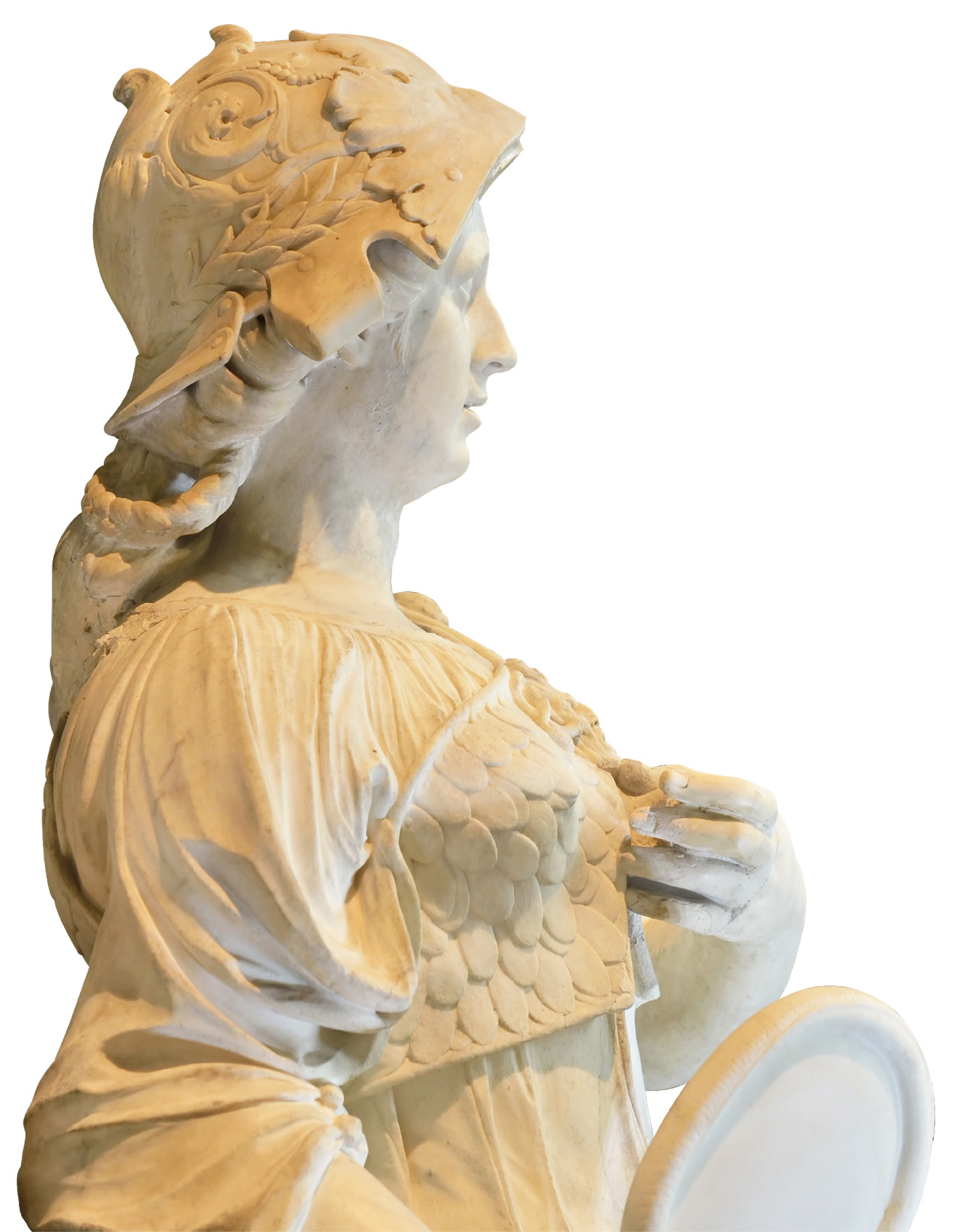
t A delicately carved marble statue in the Grote Kerk
In its present form, the Grote Kerk dates mainly from 1539, but major rebuilding between 1985 and 1987 has restored it to its former glory. Its most impressive feature is a stained-glass window which depicts Charles V, the Holy Roman Emperor, kneeling at the feet of the Virgin Mary.
The Gevangenpoort (prison gate) was originally the main gateway to the 14th-century castle of the counts of Holland. Later, it was turned into a jail, becoming infamous during a period of violent social unrest in the late 17th century when burgomaster Cornelis de Witt was confined and tortured here. Both he and his brother Jan were subsequently tried for heresy, and torn limb from limb outside the prison gate by a rioting mob.
Now a prison museum, the guided tour explores a unique collection of torture instruments, accompanied by a stereo soundtrack of blood-curdling screams.
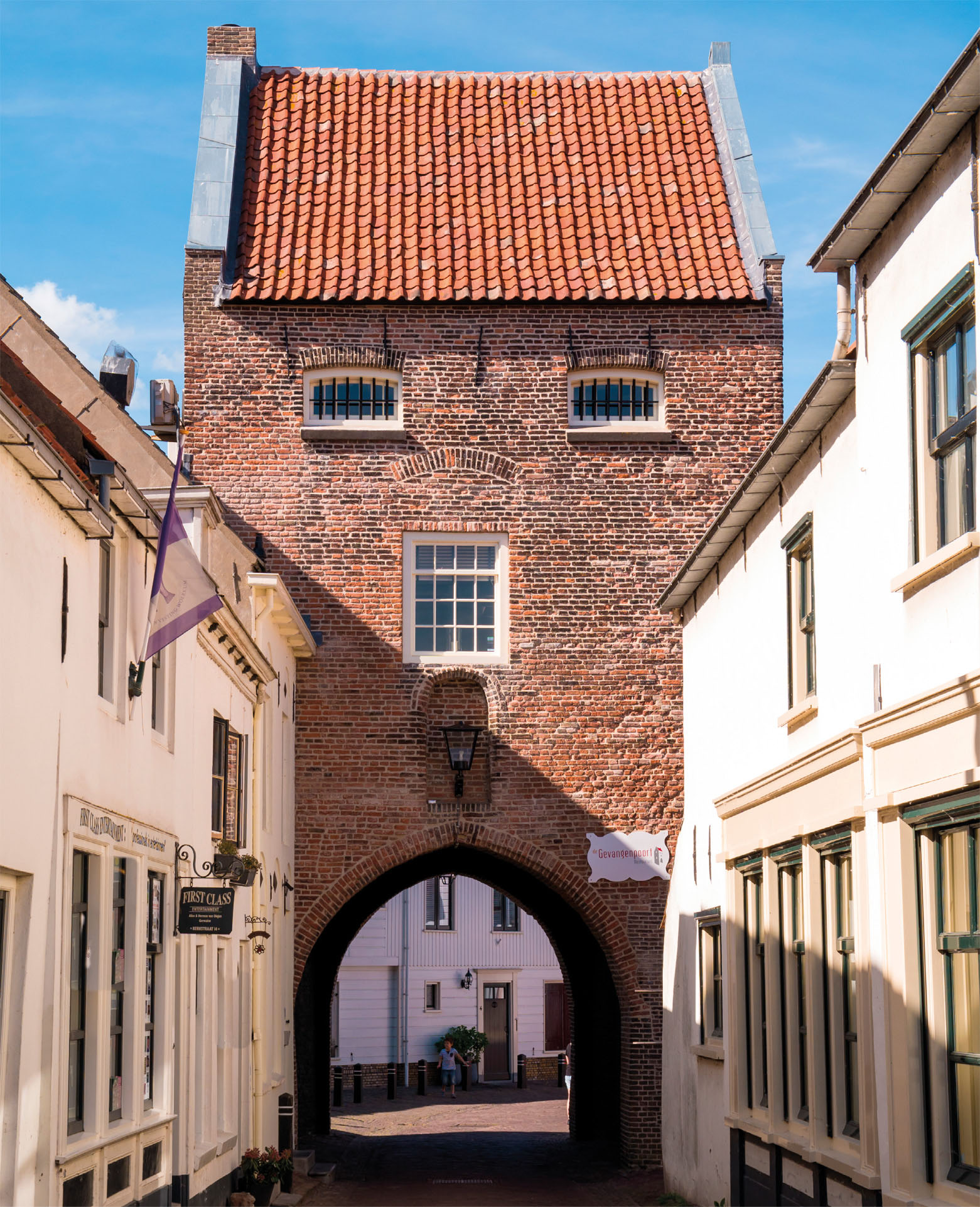
t The medieval gateway of the Rijksmuseum Gevangenpoort
The Count of Nassau, Johann Maurits, commissioned this graceful house while he was the governor of Brazil. It was completed in 1644 by Pieter Post and Jacob van Campen in Dutch Classical style with influences from Italian Renaissance architecture, and enjoys wonderful views across the Hofvijver (lake). The mansion was bequeathed to the state after Maurits’ death in 1679, and has been the home of the Royal Picture Gallery since 1822. The collection is small (laid out over only three floors), but almost every painting is a superb work by one of the Old Masters. This, combined with the exquisite presentation in elegant period rooms, with sparkling chandeliers and immense painted ceilings, makes the Mauritshuis one of the finest galleries in the Netherlands. One of the highlights of the Mauritshuis’s collection is Rembrandt’s representation of surgeons examining a corpse. This large-scale painting reflects the burgeoning contemporary interest in anatomy and science in the 17th century.
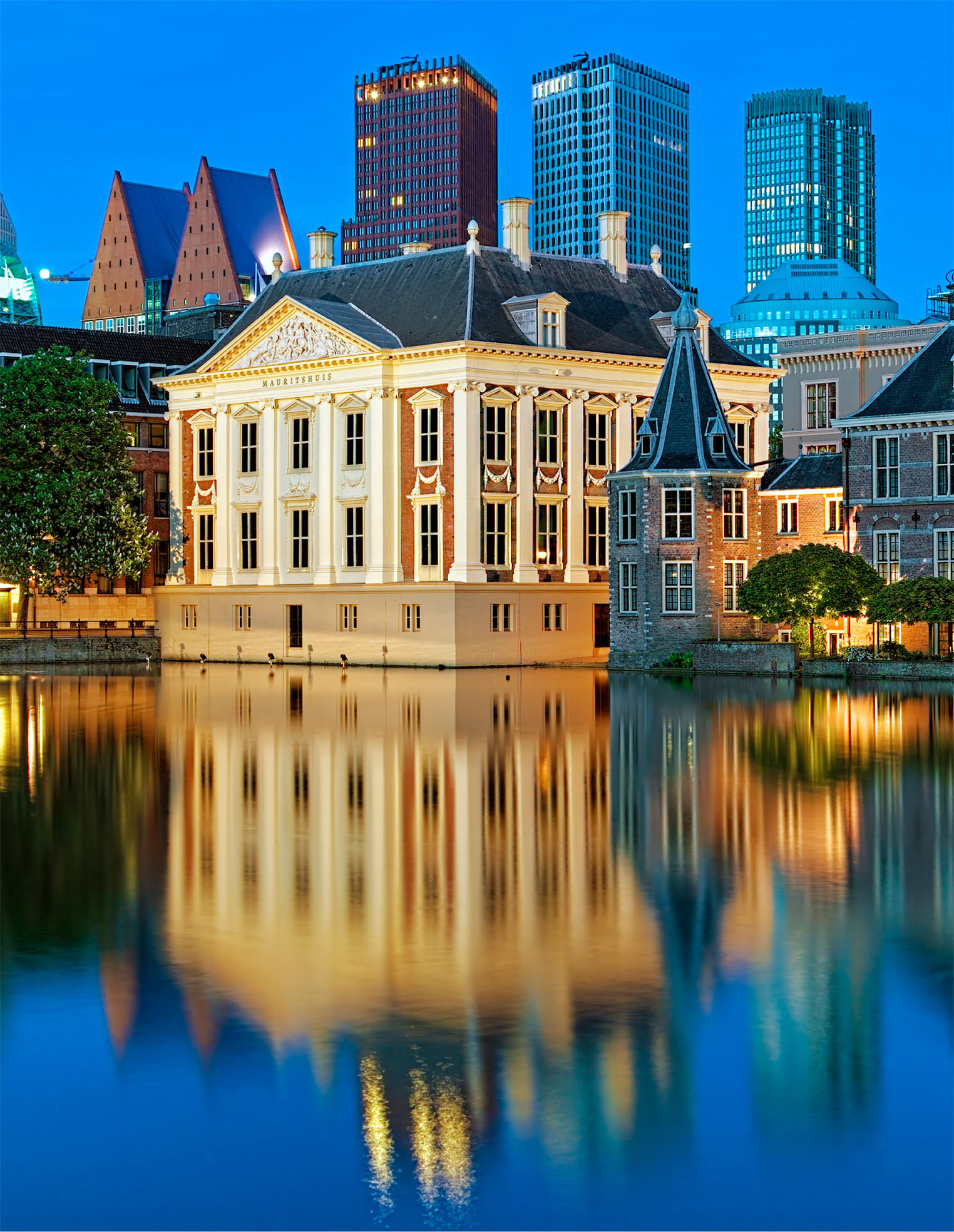
t The magnificent Mauritshuis, reflected in the Hofvijver
The arrangement of the paintings changes frequently in order to cover all aspects of the collection, but you can check the current display on the museum’s website. Information sheets and an excellent audio tour are available in English.
The Royal Dutch Shell Wing, an exhibition wing, which opened in 2014, is connected to the historic building by an innovative underground foyer, which also houses a brasserie and a museum shop, selling beautiful coffee-table books.
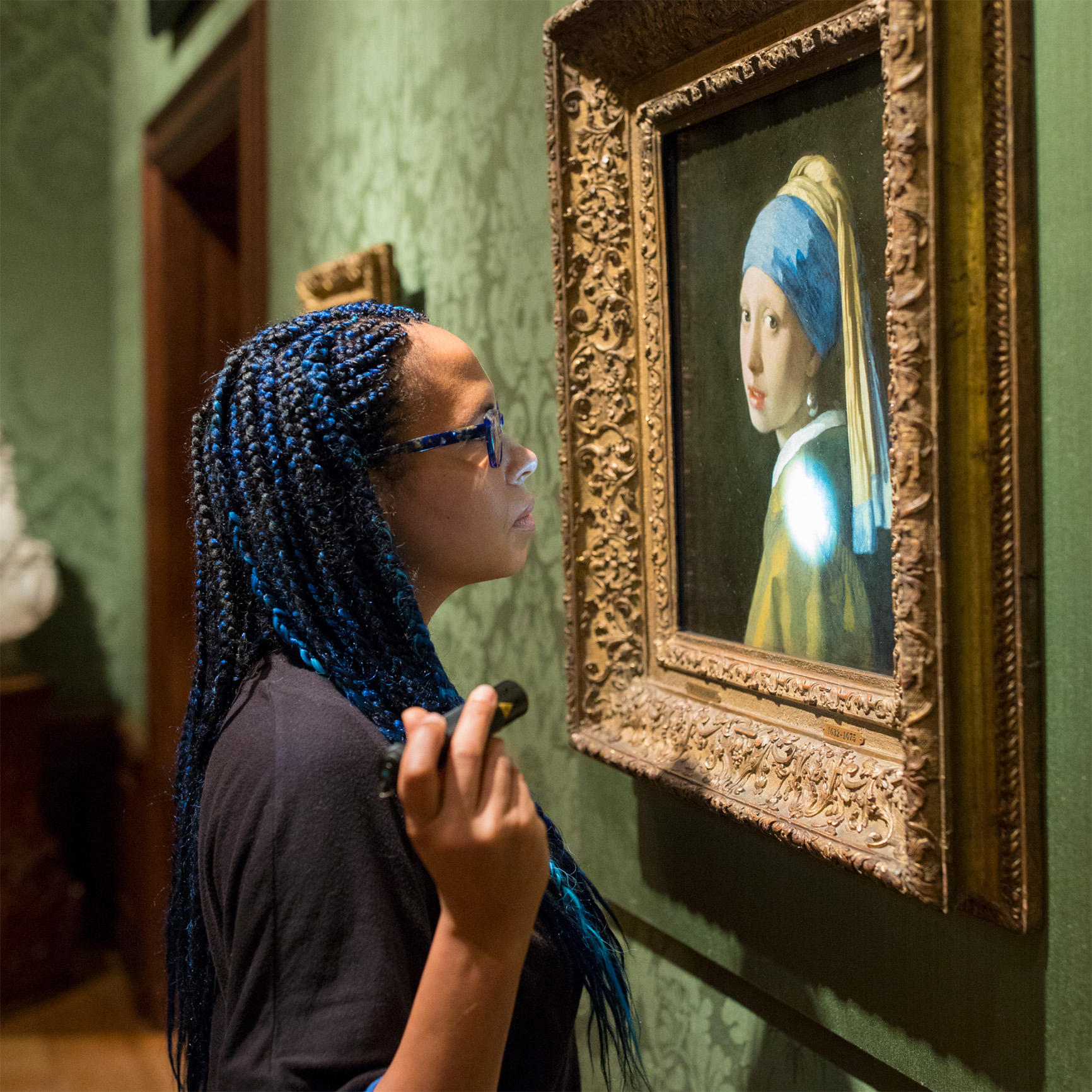
t Home to Vermeer's Girl with a Pearl Earring
Beyond The Centre Must See

Girl with a Pearl Earring (1665–67)
Johannes Vermeer’s most famous portrait
The Anatomy Lesson of Dr Nicolaes Tulp (1632)
Rembrandt’s painting of surgeons examining a corpse
The Goldfinch (1654)
Tiny, delicate work by Carel Fabritius
Hunting for Lice (c 1652–53)
Gerard ter Borch’s scene of a mother grooming her child’s hair
Roses in a Glass Vase (c 1640–45)
Delicate still life by Jacob van Hulsdonck

t Miniature buildings in a recreated city, Madurodam
Madurodam is a 1:25 scale model of a composite Dutch city. It incorporates replicas of the Binnenhof in Den Haag, the canal houses of Amsterdam, Rotterdam’s Europoort and Schiphol airport, along with windmills, polders and bulbfields. At night it is illuminated by tiny lights. The model city was opened by Queen Juliana in 1952. It was conceived by J M L Maduro as a memorial to his son George, who died at Dachau concentration camp in 1945.
Johann Maurits built the Mauritshuis with wealth gained from his slave-owning plantations in Dutch Brazil.
This painted cyclorama is important both as a work of Dutch Impressionism and as a rare surviving example of 19th-century entertainment. The vast painting, the largest circular canvas in Europe, is 120 m (400 ft) in diameter and lines the inside wall of a circular, canopied pavilion. The magical optical illusion makes visitors feel that they are standing in the old fishing village of Scheveningen.
The astonishingly realistic effect of the painting is achieved through the brilliant use of perspective, enhanced by natural daylight from above. It was painted in 1881 by members of the Dutch Impressionist School, led by H W Mesdag (1831–1915) and his wife, Sientje (1834–1909). George Hendrik Breitner (1857–1923) later added a group of cavalry officers charging along the beach on horseback. Constructed specially for the painting, the building itself has been renovated and extended, creating more space for temporary exhibitions.
Beyond The Centre Must See
|
STAY Hotel des Indes Open since 1884, this grand hotel is redolent of the belle époque, filled with gilt mirrors and chandeliers. ⌂ Lange Voorhout 54–56 ∑ hoteldesindesthehague.com ¡¡¡ Stadsvilla Hotel Mozaic This small hotel offers stylishly decorated rooms in classic monochrome colours. ⌂ Laan Copes van Cattenbuch 38–40 ∑ mozaic.nl ¡¡¡ |
Beyond The Centre Must See
|
EAT Restaurant des Indes The opulent restaurant of Den Haag’s grandest hotel serves French-inspired, classically presented steak and seafood such as Dover sole. ⌂ Lange Voorhout 54–56 ¢ Sun & Mon ∑ desindes.nl ¡¡¡ Garoeda This long-established restaurant, which opened in 1949, serves Dutch-Indonesian meat, fish and vegetable dishes, including satay skewers and rijsttafels (small dishes served with rice). ⌂ Kneuterdijk 18A ∑ garoeda.com ¡¡¡ |
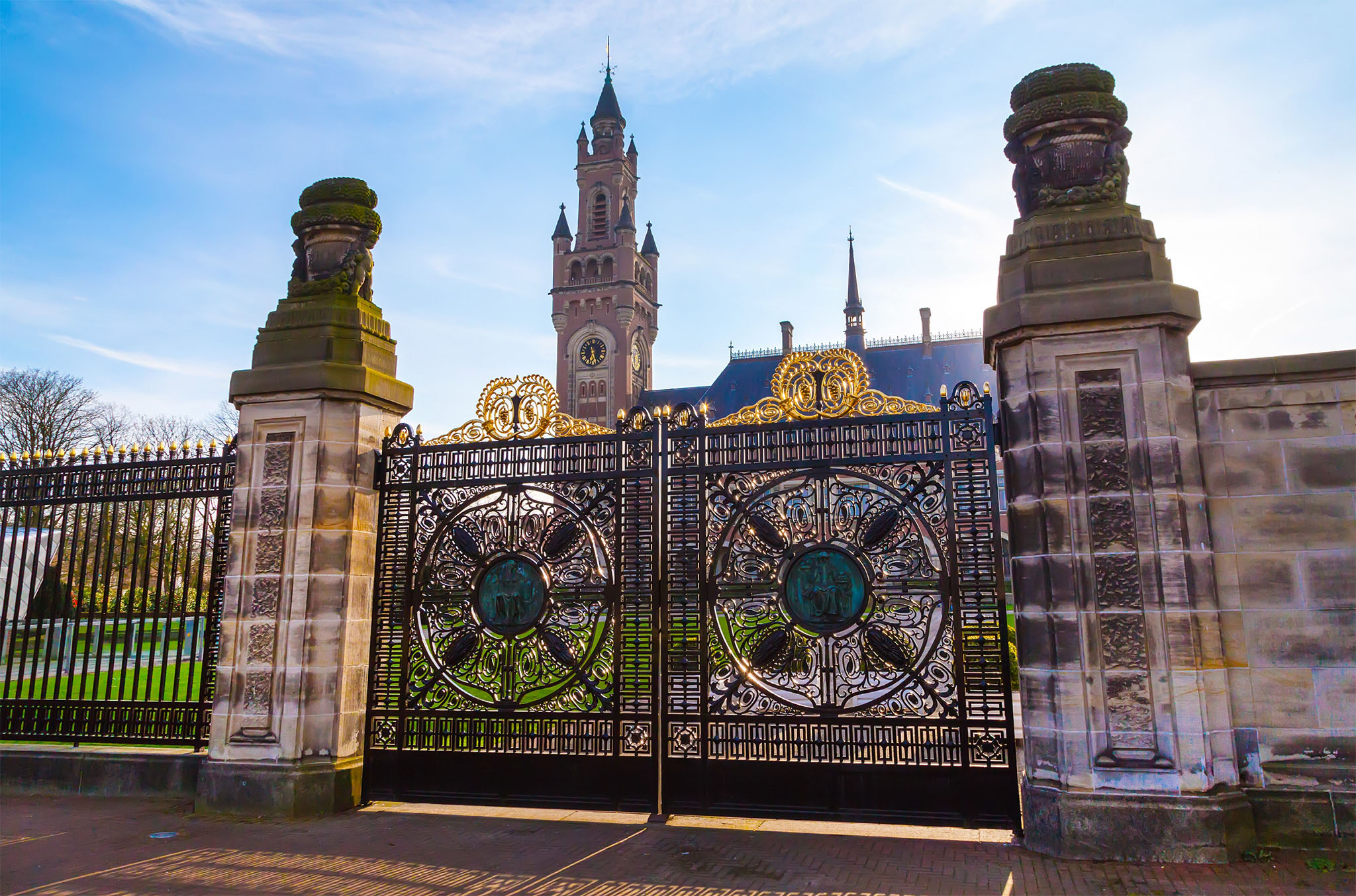
t Vredespaleis, home to the International Court of Justice
In 1899, Den Haag played host to the first international peace conference. This then led to the subsequent formation of the Permanent Court of Arbitration, which had the aim of maintaining world peace. To provide a suitably august home for the court, the Scottish-born philanthropist Andrew Carnegie (1835–1919) donated $1.5 million towards the building of the mock-Gothic Vredespaleis (peace palace), which was designed by French architect Louis Cordonnier.
The enormous palace was completed in 1913, and many of the member nations of the Court of Arbitration contributed to the interior’s rich decoration. Today the Vredespaleis is the seat of the United Nations’ International Court of Justice, which was formed in 1946 as successor to the Permanent Court of Arbitration. There is a visitors’ centre but the building itself is open to the public only via a guided tour (check dates and book tickets via the website).
In his youth, Prince William V was a collector of Golden Age paintings. His collection was opened to the public in 1774, inside this former inn, which the prince had converted for use as his kabinet – the 18th-century Dutch word for an art gallery. The Galerij is the oldest art gallery in the Netherlands. The 18th-century fashion for covering every available inch of wall space with paintings has been retained, and so several pictures are hung high and close together. Many of Prince William’s original purchases are still to be seen. Old Master paintings by Rembrandt, Jan Steen and Paulus Potter (1625–54) are included in a collection that consists principally of typically Dutch Golden Age landscapes, genre works, “conversation pieces” and recreations of important historical events.

t Visitors observing the art at Galerij Prins Willem V
Beyond The Centre Must See
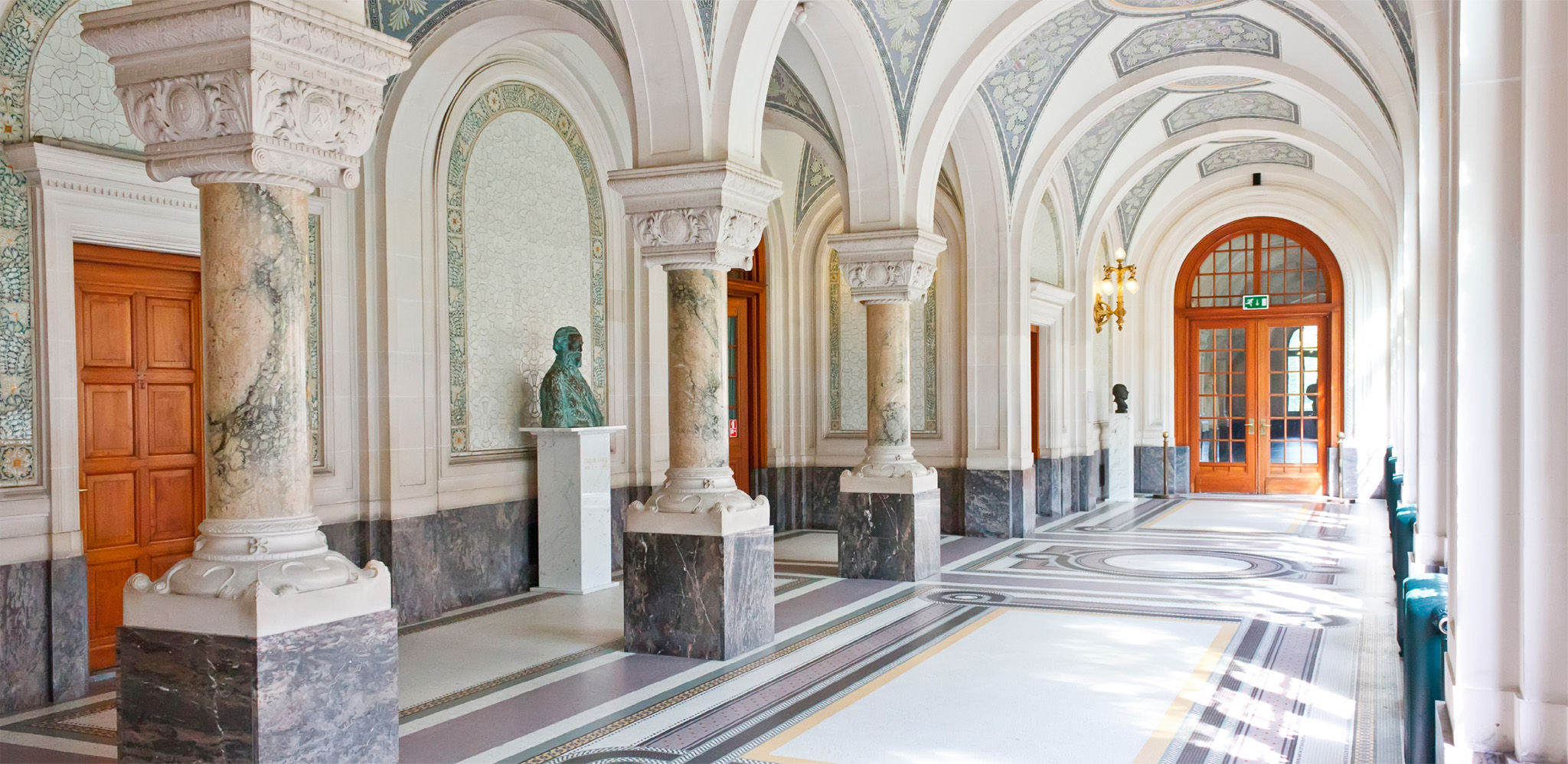
Den Haag is known the world over for being home to the International Court of Justice – the highest court of the United Nations. The court’s 15 judges are elected for nine-year terms by the UN General Assembly and Security Council, and are tasked with settling legal disputes between states submitted by UN members. It’s often confused with both the Court of Justice of the European Union, based in Luxembourg, and the European Court of Human Rights, in Strasbourg.
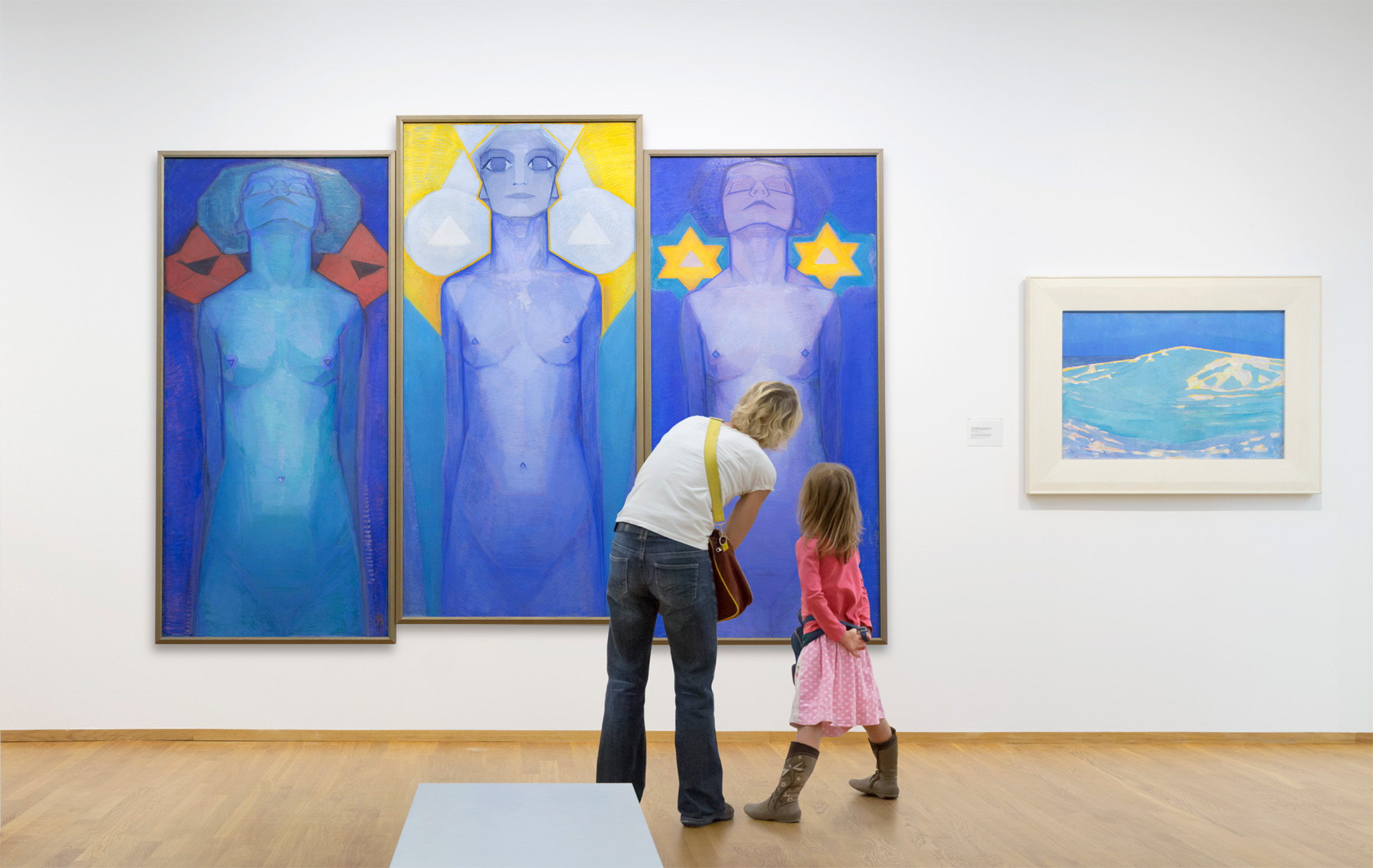
t Admiring artworks in the Gemeentemuseum Den Haag
This is one of the city’s finest museums. The delightful building was the last work of H P Berlage, the father of the architectural movement known as the Amsterdam School. The museum was completed in 1935, a year after his death, and is built in sandy-coloured brick on two storeys round a central courtyard, with every room open to daylight.
The exhibits are displayed in three sections. Highlights of the superb applied arts section include antique delftware, Islamic and Oriental porcelain and the world’s largest collection of paintings by Piet Mondriaan.
Costumes and musical instruments dating from the 15th to the 19th centuries are too fragile to be put on permanent display, but selected items are regularly exhibited.
The labyrinthine basement is the stage for the “Wonderkamers” (the Wonder Rooms), which hold quirky displays of artworks from all the collections, aimed especially at teenage visitors.
With as many as 35 temporary exhibitions each year, the Gemeentemuseum has a constantly evolving scene. The extensive exhibition programme offers something for everyone – topics ranging from the role of the colour black in the history of fashion to Picasso’s Cubist sculptures have all had their place in the museum’s programme. Snaffle up a ticket online before you visit and learn about something in depth.